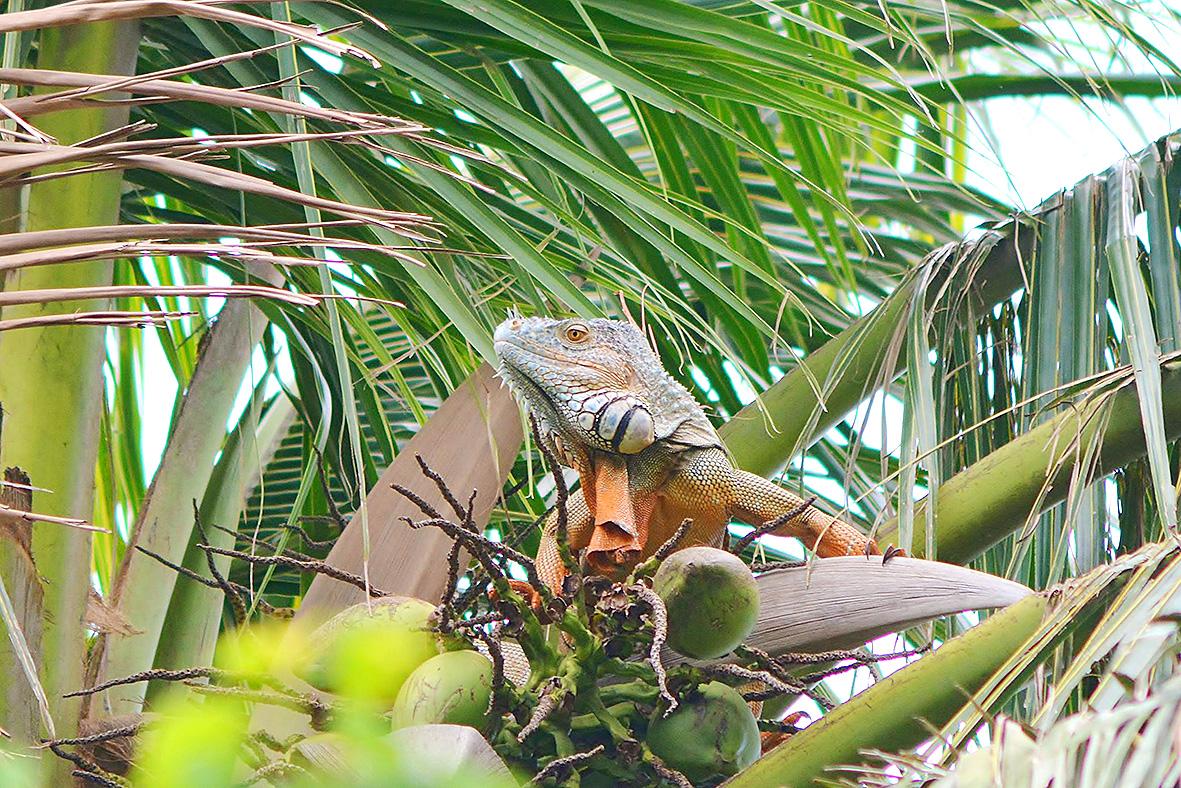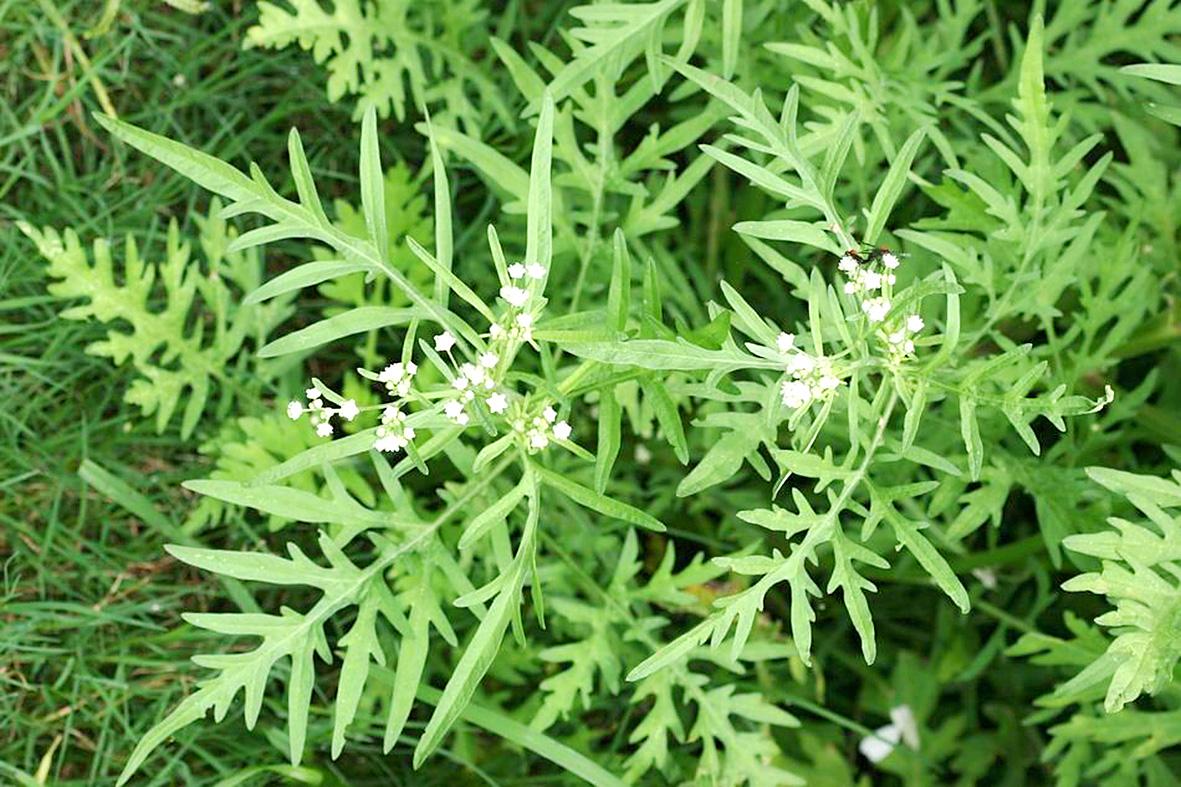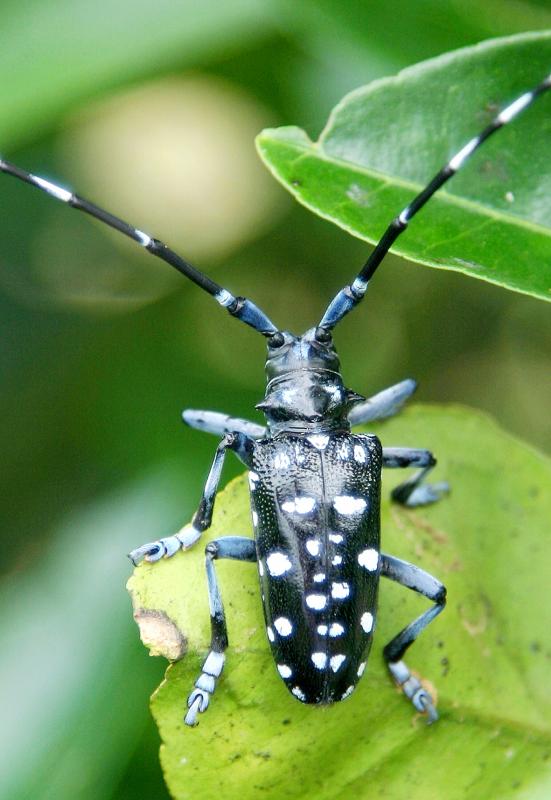When I visited John Lamorie’s eco-farm in Pingtung a few weeks ago, the first thing I saw when I stepped out of his car was an iguana running along the ditch that borders his property. “It’s been hanging around there for weeks,” he said. “Can’t get rid of him.”
An invasive species from an exotic land that looks like a monster (the 1998 Godzilla film hints that Godzilla is a mutated iguana), iguanas have been in the spotlight for a year now, with a spate of articles highlighting their growing presence in southern Taiwan. The government banned their import in 2015, and 15,000 were killed in Taiwan last year, over 8,000 in Pingtung alone.
Like most invasive species in sensitive island environments, they are extremely destructive. They burrow, damaging irrigation infrastructure, and they compete with local species for resources. They were first reported on Taiwan island in 2004, likely as the result of an intentional release. Several local governments now offer bounties for them.

Photo: CNA
‘INTERESTING CASES OF SPECIATION’
Taiwan is a special place. Because it sits on the boundary between two major zoogeographical zones, the Indomalaya and the Palearctic, it hosts lineages from both areas. There are over 100 amphibians and lizards native to Taiwan, with roots in both regions.
Since Taiwan is cut up into numerous tiny regions by high mountains and fast-moving rivers, the island presents interesting cases of speciation. For example, lizards of the genus Takydromus are distributed widely in the Palaearctic regions, and reach their greatest diversity in Taiwan. A 2015 paper found that speciation occurred between T. viridipunctatus and T. luyeanus, two species separated by a narrow stream only 15 meters wide, “one of the narrowest contact zones ever documented in terrestrial vertebrates”, the authors observed.

Photo courtesy of Hualien County Government
Invasive species threaten these unique and precious creatures. The many-lined sun skink, which was first found in southern Taiwan in 1992, likely introduced as a result of timber imports, has reduced populations of native skinks in the south. Similarly, the tree frog Polypedates megacephalus, first noted in 2006, has pushed out a local cousin whose niche it also competes in wherever it appears in Taiwan.
Smaller introduced pests, such as the white spotted longhorn beetle, rice water weevil, the pine wood nematode, and the apple snail, do great and costly harm to the ecosystem and the economy. The pine wood nematode causes pine wilt, which kills pine trees. It can fell a healthy tree in less than two weeks. Outbreaks in Taiwan in the 1990s caused great damage to Taiwan’s native pines, including the hardy Taiwan red pine.
The story of the pine wood nematode is intertwined with the story of other introduced species. On the plains, most pines are introduced. For example, the Japanese black pine was planted by settlers after they cleared the native coastal forests, because it is wind and salt resistant.

Photo: CNA
In 1960s Luchu pines were planted in northern Taiwan to provide fodder for pulpwood mills. They became so common that then-Taipei County chose the plant as its county tree. Unfortunately, it proved unsuccessful as a source of pulp. The trees were left to run wild by plantation owners, and they later became excellent hosts for the pine wood nematode.
The white spotted longhorn beetle, a familiar sight with its long black body, long antennae, and white spots, is an import from elsewhere in Asia. Its larvae cause millions in fruit losses each year. To avoid drenching their orchards with pesticides, farmers in Taiwan now kill them by the tedious process of injecting compressed air into the trunks of their fruit trees.
GREEN DAMAGE
The public discussion focuses on exotic animals, insects, and fish (snakeheads in Sun Moon Lake were again in the news this week). Plants seldom get much attention. Yet the damage they do is immense.
Consider American rope aka climbing hemp (Mikanthia micrantha), a climbing plant now found in the mountains of Hualien, Taitung, Changhua, and Nantou. Its seeds are miniscule (a thousand can weigh less than a gram), easily spread by wind, insects, animals, and humans. Plants and trees covered by American rope obtain less sunlight, and may die.
The Japanese introduced the water hyacinth as an ornamental. Long out of control, it now blocks waterways of every type and clogs reservoirs and power plants. It sucks the oxygen out of the water and drives a threefold increase in evaporation. It is deadly to local life forms, while creating habitats for harmful bugs and destroys aquaculture. At some local reservoirs grass carp, which eats hyacinth, is used for pest control.
Another water plant, Saltmarsh cord grass, often planted in intertidal areas because it captures sediment and engineers shorelines, is a pest in Taiwan. It can block water infrastructure and create conditions that extinguish local lifeforms.
Taiwan now hosts the extremely destructive Parthenium hysterophorus, a plant so toxic to other plants it is colloquially known as “famine weed” because of the way it suppresses crop yields with nasty chemicals. It also causes dermatitis in both humans and domestic animals, and respiratory malfunction and allergies in humans. Having spread to over 30 countries, the European Union has banned its sale and importation. It colonizes disturbed land, of which there is plenty in Taiwan with our constant construction churn, and spreads through contaminated feed and even plant bouquets.
Invasive species also carry diseases. Some species of invasive slugs and snails in Taiwan carry a worm that causes a form of meningitis in humans, including the ubiquitous giant African snails.
Mirroring their behind-the-scenes existence, Taiwan also has programs seldom observed by the public to control and eventually eradicate imported pests. The Polynesian Rat likely traveled to Taiwan by ship. It was first spotted in Taiwan in the late 1990s, in Hualien. The Bureau of Animal and Plant Health Inspection and Quarantine (BAPHIQ) of the Council of Agriculture (COA) immediately initiated a program to use poisoned baits to reduce its population and prevent its spread.
With the red fire ant, one of the most obnoxious of invasive species, local governments have established offices specifically to attack the pest. For example, New Taipei City has an agency, the Red Imported Fire Ant Center, devoted to suppressing the ant. The center said in a recent article that it had reduced the areas infested by the creatures from 7,000 hectares to 4,000.
Still, madly, we continue to permit exotic creatures to be imported. Exotic pets sold in Taiwan include monitor lizards, snapping turtles, and pythons, all of which could find a congenial home on the island. Even if such trade were forbidden, Taiwan’s dependence on imports means that invasive species will arrive riding on otherwise innocuous goods.
The government does what it can to limit the entrance and spread of invasive species, but what is really needed is better public education in the dangers of keeping exotic pets and intentionally releasing unwanted animals into the wild. Long-term cultural change, something the Taiwanese have repeatedly shown they are capable of, would really help Taiwan in this case.
Notes from Central Taiwan is a column written by long-term resident Michael Turton, who provides incisive commentary informed by three decades of living in and writing about his adoptive country. The views expressed here are his own.

The Democratic Progressive Party (DPP), Chinese Nationalist Party (KMT), and the country’s other political groups dare not offend religious groups, says Chen Lih-ming (陳立民), founder of the Taiwan Anti-Religion Alliance (台灣反宗教者聯盟). “It’s the same in other democracies, of course, but because political struggles in Taiwan are extraordinarily fierce, you’ll see candidates visiting several temples each day ahead of elections. That adds impetus to religion here,” says the retired college lecturer. In Japan’s most recent election, the Liberal Democratic Party lost many votes because of its ties to the Unification Church (“the Moonies”). Chen contrasts the progress made by anti-religion movements in

Taiwan doesn’t have a lot of railways, but its network has plenty of history. The government-owned entity that last year became the Taiwan Railway Corp (TRC) has been operating trains since 1891. During the 1895-1945 period of Japanese rule, the colonial government made huge investments in rail infrastructure. The northern port city of Keelung was connected to Kaohsiung in the south. New lines appeared in Pingtung, Yilan and the Hualien-Taitung region. Railway enthusiasts exploring Taiwan will find plenty to amuse themselves. Taipei will soon gain its second rail-themed museum. Elsewhere there’s a number of endearing branch lines and rolling-stock collections, some

Last week the State Department made several small changes to its Web information on Taiwan. First, it removed a statement saying that the US “does not support Taiwan independence.” The current statement now reads: “We oppose any unilateral changes to the status quo from either side. We expect cross-strait differences to be resolved by peaceful means, free from coercion, in a manner acceptable to the people on both sides of the Strait.” In 2022 the administration of Joe Biden also removed that verbiage, but after a month of pressure from the People’s Republic of China (PRC), reinstated it. The American

This was not supposed to be an election year. The local media is billing it as the “2025 great recall era” (2025大罷免時代) or the “2025 great recall wave” (2025大罷免潮), with many now just shortening it to “great recall.” As of this writing the number of campaigns that have submitted the requisite one percent of eligible voters signatures in legislative districts is 51 — 35 targeting Chinese Nationalist Party (KMT) caucus lawmakers and 16 targeting Democratic Progressive Party (DPP) lawmakers. The pan-green side has more as they started earlier. Many recall campaigns are billing themselves as “Winter Bluebirds” after the “Bluebird Action”